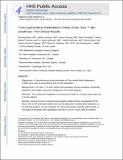Transapical Mitral Implantation of the Tiara Bioprosthesis
Author(s)
Banai, Shmuel; Verheye, Stefan; Cheung, Anson; Schwartz, Marc; Marko, Alexei; Lane, Randy; Jolicoeur, E. Marc; Garceau, Patrick; Biner, Simon; Tanguay, Jean-Francois; Edelman, Elazer R.; White, Christopher J.; ... Show more Show less
DownloadEdelman_Transapical mitral.pdf (3.109Mb)
PUBLISHER_CC
Publisher with Creative Commons License
Creative Commons Attribution
Terms of use
Metadata
Show full item recordAbstract
Objectives:
This study sought to describe the pre-clinical evaluation of transapical mitral implantation of the Tiara (Neovasc Inc, Vancouver, British Columbia, Canada) valve in preparation for first-in-man implantation.
Background:
The Tiara is a transcatheter self-expanding mitral bioprosthesis, specifically designed for the complex anatomic configuration of the mitral apparatus.
Methods:
Tiara valves were implanted in a short-term porcine model, in a long-term ovine model, and in human cadavers.
Results:
Short-term and long-term evaluation demonstrated excellent function and alignment of the valves, with no left ventricular outflow tract obstruction, coronary artery obstruction, or transvalvular gradients. Long-term evaluation of 7 sheep demonstrated clinically stable animals. A mild degree of prosthetic valve regurgitation was seen in 2 of the 7 sheep. A mild-to-moderate degree of paravalvular leak, which was attributed to this animal model, was observed in 6 of these animals. Cardioscopy and macroscopic evaluation demonstrated stable and secure positioning of the Tiara valve with no evidence of injury to the ventricular or atrial walls. Pericardial leaflets were free and mobile without calcifications. Implantation of the Tiara valves in human cadaver hearts demonstrated, upon visual inspection, proper anatomic alignment and seating of the valve, both at the atrial and at the ventricular aspects of the native mitral apparatus.
Conclusions:
In preparation for the first-in-man transcatheter mitral valve implantation, we report the successful pre-clinical evaluation of the Tiara transcatheter self-expanding mitral bioprosthetic valve. In porcine and ovine models without mitral regurgitation, transapical mitral implantation of the Tiara valve is technically feasible and safe, and results in a stable and well-functioning mitral bioprosthesis.
Date issued
2014-02Department
Massachusetts Institute of Technology. Center for Biomedical EngineeringJournal
JACC: Cardiovascular Interventions
Publisher
Elsevier
Citation
Banai, Shmuel, Stefan Verheye, Anson Cheung, Marc Schwartz, Alexei Marko, Randy Lane, E. Marc Jolicoeur, et al. “Transapical Mitral Implantation of the Tiara Bioprosthesis.” JACC: Cardiovascular Interventions 7, no. 2 (February 2014): 154–162.
Version: Author's final manuscript
ISSN
19368798